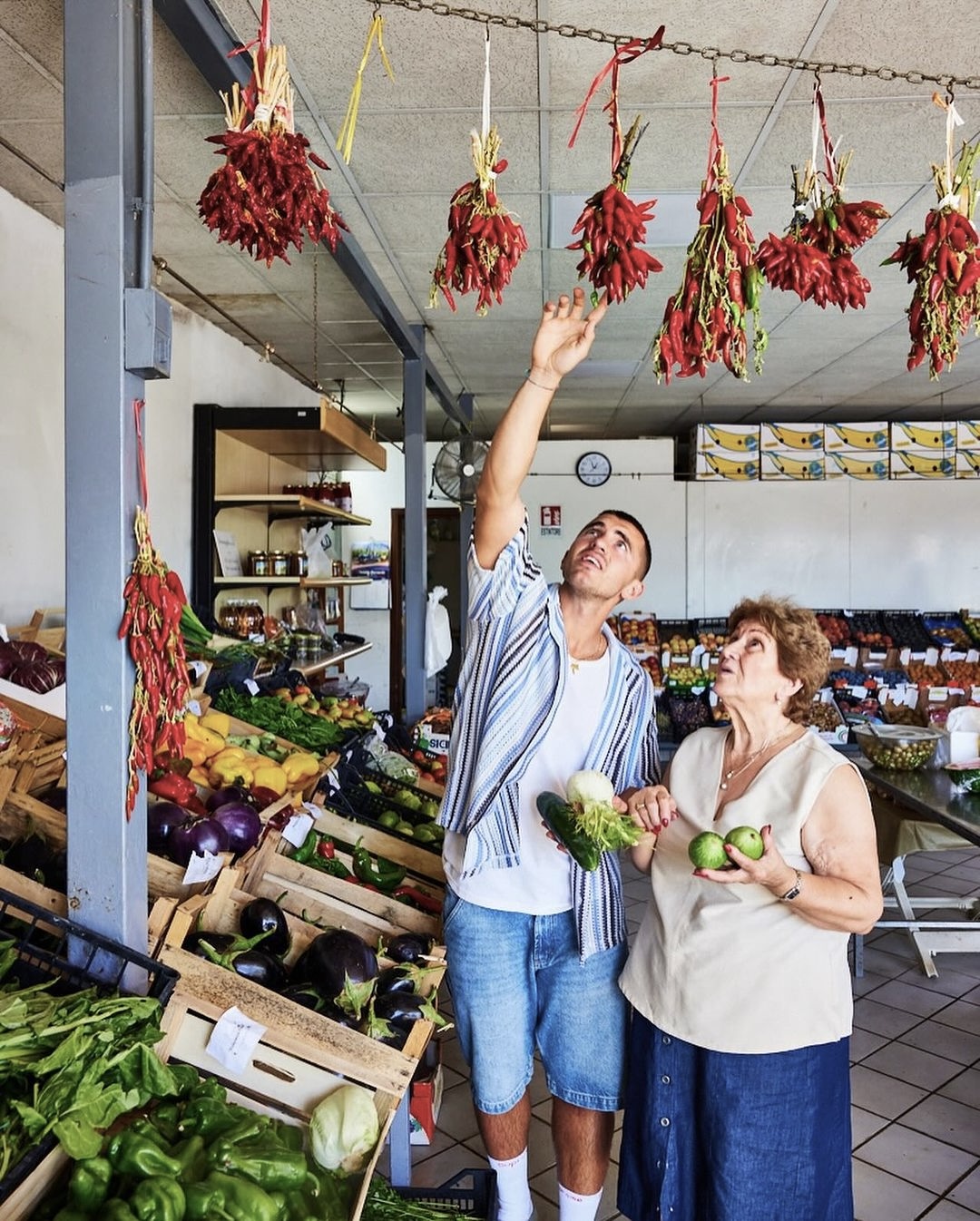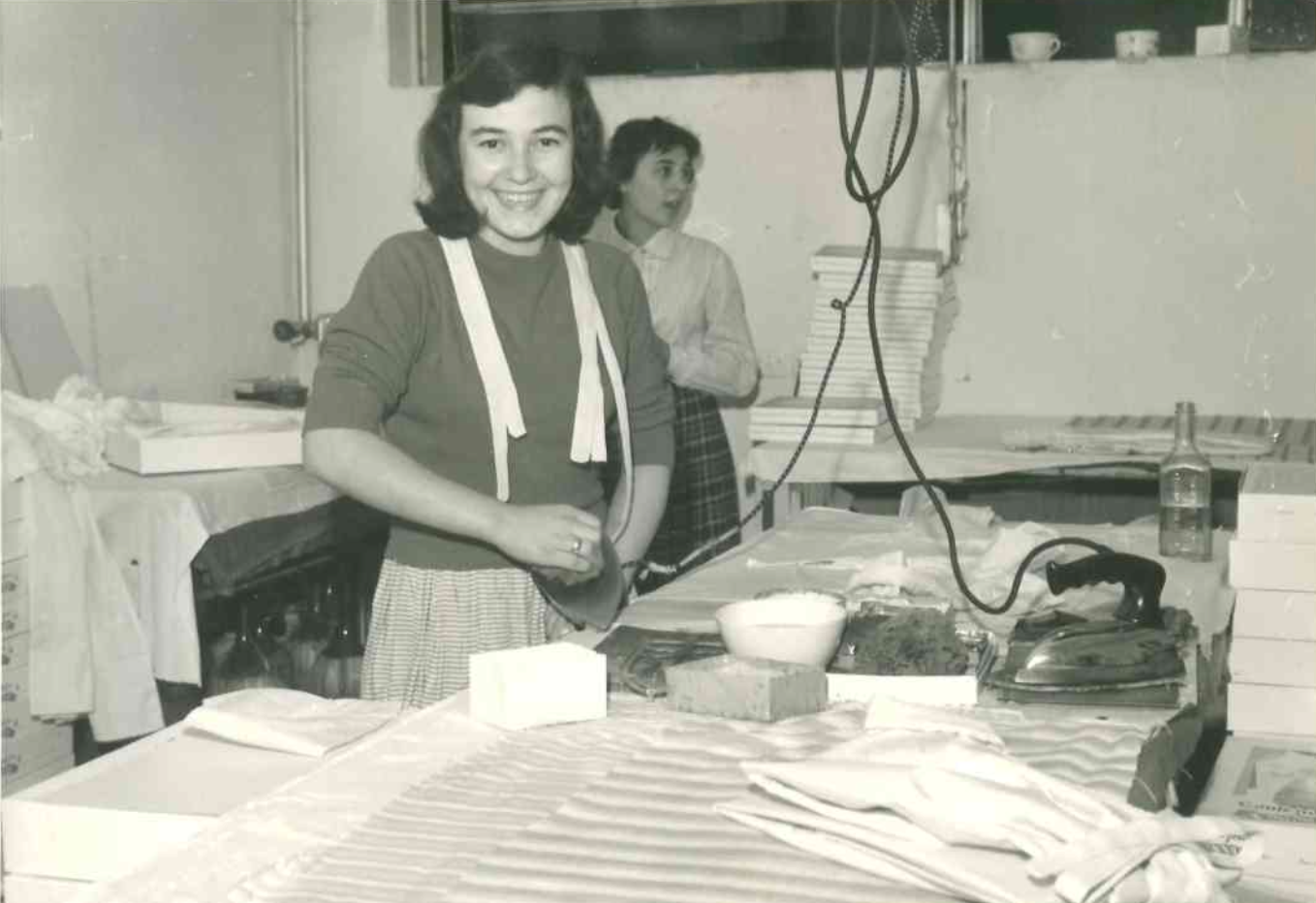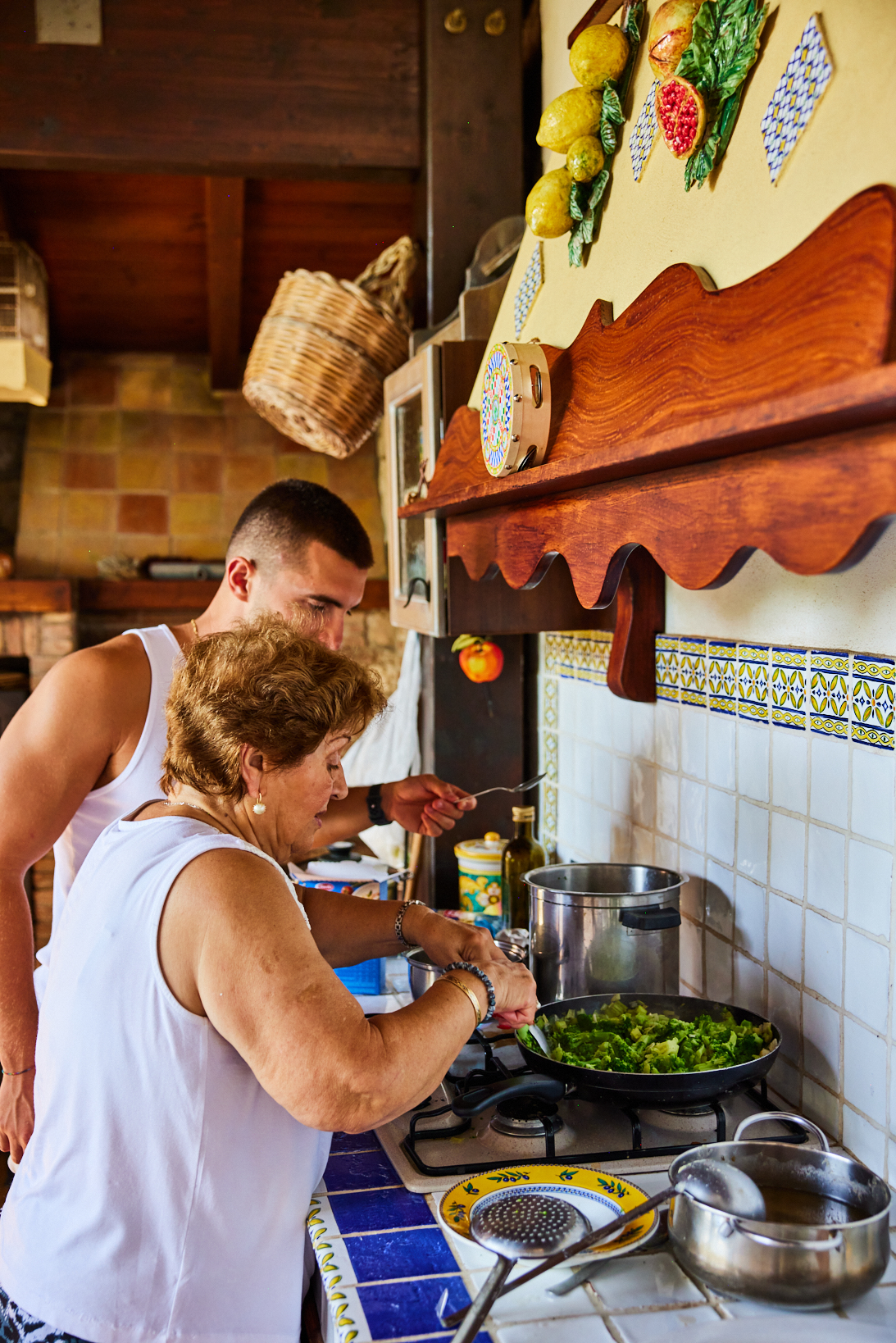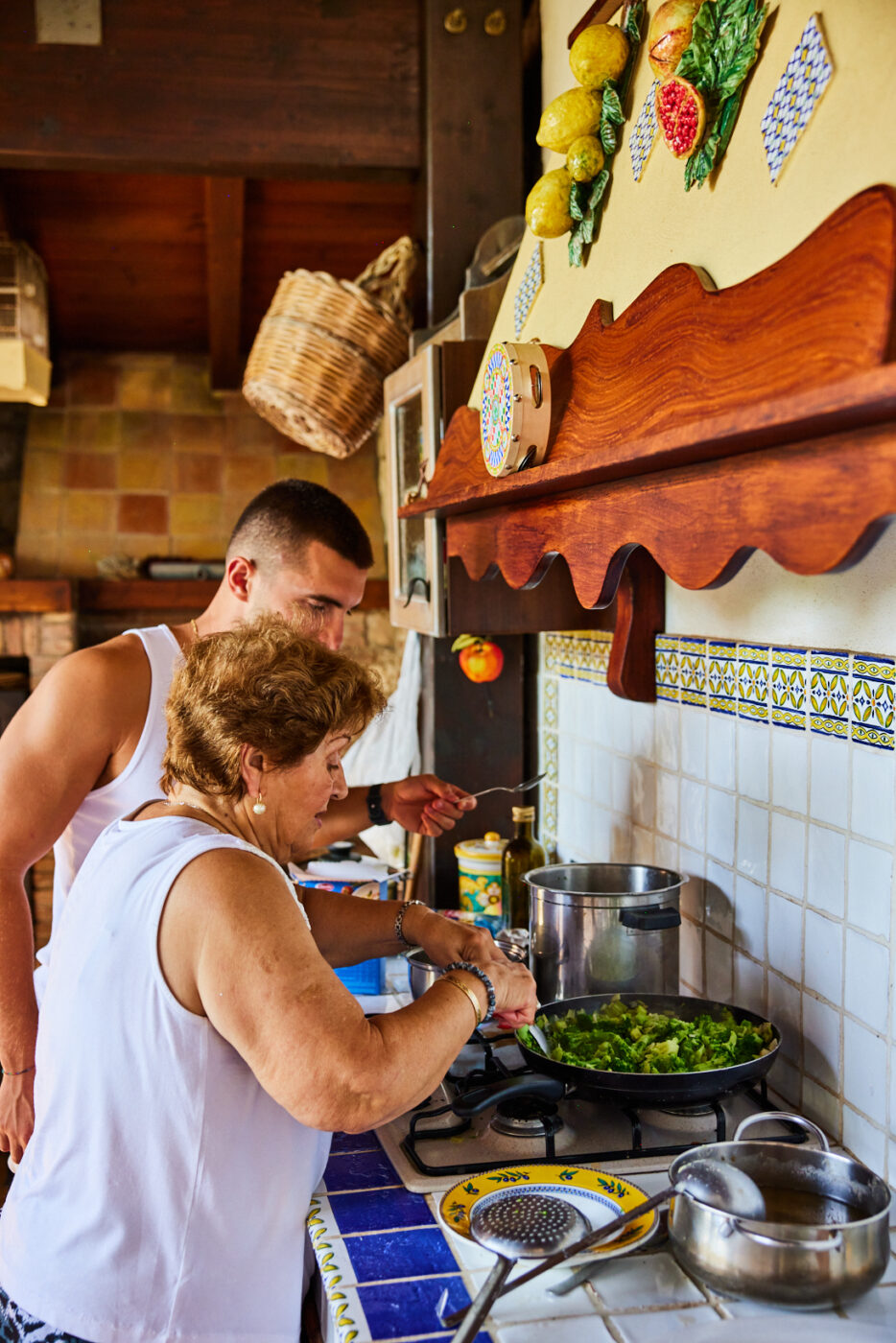1.7 million viewers tune in to watch 85-year-old Nonna Marianna cook sugo ai piselli or make espresso on her grandson Giuseppe’s account (@sepps_eats). Elsewhere, 77-year-old Nonna Fina (@mynonnafina) is seen being pranked by her granddaughter Maddie, ranking Met Gala looks, and sharing her recipe for lemon biscuits. And then there is 84-year-old Nonna Silvi (@nonnasilvioffical), who can be found at work at her son’s bakery, Forno Martini, explaining to 1.6 million followers (with a trademark thick Florentine accent) how to prepare pasta con tonno or schiacciata Toscana.
TikTok is only the latest corner of the internet to discover and quickly fall in love with Italian grandmothers. Vicky Bennison started the “Pasta Grannies” YouTube channel ten years ago to create a record of the diverse pasta-making traditions dying out in the domestic sphere across Italy. Since then, she has found and filmed upwards of 400 nonne and enjoyed stratospheric success; Pasta Grannies has almost a million subscribers, spawned two cookbooks, and gone global, even having been made available on the Chinese video website Bilibili. She found that viewers “came for the pasta and stayed for the grannies.” When asked about the enduring internet appeal of the nonna, Bennison says, “Homo sapiens is hard-wired to love grandmothers and kittens, and when you have one regular face, then folks really connect.”
It is no surprise, then, that, as TikTok usage spiked during the COVID-19 pandemic, nonne shot to fame on the platform. The warmth of a grandmother was the perfect tonic for the isolation and anxiety of the time. As Nonna Silvi says, “You can’t not get attached to a grandmother.”

Nonna Silvi
Nonna Fina’s granddaughter, Maddie, was missing her nonna during lockdown and posted a video of her hilariously spelling barbeque steak “BARBACKW STACK.” The TikTok went viral, and since then, Maddie has been told off by Nonna Fina for saying she wants lip filler (“your lips will look like a braciola”), presenting her with tinned spaghetti (“do you think I’m a dog?”), and offering a Starbucks caramel macchiato (“junk”). Once a nonna goes viral, it’s common that she branches out into multiple arms of lifestyle content, whether a celebration of annual sauce day or the behind-the-scenes of Sunday dinner. Generally speaking, Maddie and Nonna Fina tend to share videos of their playful wisecracking, while other nonne, like Nonna Silvi and Nonna Marianna, focus more on foodie instruction.
And this is the nexus of the nonne’s TikTok fame: FoodTok. FoodTok is a low-fi, candid corner of the internet that rewards authenticity and ease, a marked departure from traditional cooking media’s mega production budgets and polished studio set-up. The hashtag #foodtiktok has some 226 billion views, a gargantuan number emblematic of the enthusiastic engagement of TikTok’s younger audience, who are moving against convenience food and freezer-worship to rediscover cooking from scratch on the platform.

Nonna Fina and Maddie; photo from @mynonnafina
And who better to engage your culinary sensibility than a nonna? It’s easy to see why audiences are immediately taken with their unspoken magic, communicated through a twinkle in the eye or a conspiratorial wink to the camera. Nonna Marianna says, “I cook the same way I’ve always cooked, and people seem to like it. I cook the same way I do at home as I did in the restaurant [that she used to run with her husband], and I just forget the camera is there.” Her lack of pretension in front of the camera seems to be a pre-digital gift, a refreshing differentiation from the digital natives who usually reign supreme on TikTok.
As an intrinsically visual platform, TikTok also allows viewers to enjoy the rhythm and physicality of the nonne’s cooking. This, according to Bennison, is essential to understanding a nonna’s kitchen, where instinct rules and you are unlikely to find a recipe book or measurement. Nonne have the inherited knowledge of an age gone by—knowing on a cellular level how much Parmigiano the pasta wants—whereas now we defer to the internet for all instruction, failing to hone our instincts in the process.
New audiences accordingly revel in the nonne’s culinary wizardry and trust their generational authority. Nonna will tell you, in a no-nonsense tone, exactly how to cook your pasta. It won’t be “their way”; it will be “the way”. This is valuable currency for cutting through the saturation of FoodTok, which has democratized cooking to the extent that anyone, for better or worse, has a platform to share their version of a recipe.
It is ultimately the nonne’s inclusively simple approach of unfussy methods and accessible ingredients that all but guarantees TikTok success; there’s a low barrier to entry for viewers to get involved. Nonna Marianna concurs, saying her most popular videos have been “pasta with broccoli and pasta with garlic… I think because they are so simple to make and people like that.”

Nonna Marianna and Giuseppe; photo courtesy of David Loftus
Indeed, the nonna’s arrival on TikTok has happened at an auspicious time: cucina povera has found itself in vogue throughout Europe and the US. More and more people are reducing their meat intake and trying to eat diets that rely more heavily on vegetables. This approach to food and notions of sustainability–following the seasons and reducing waste (e.g. using every part of the animal)–are the natural reflexes of a nonna. Far from a romantic aesthetic, it is instead a life-long practice of frugality that has taught them to cook creatively with what they have.
Herein lies an aspect of the nonna’s lives that is forgotten in favor of shorehorning them into the “cute and cuddly” category. Growing up against the backdrop of world wars and poverty has shaped these women to be fundamentally resilient, with iron-clad resolve and an assiduous work ethic; it must not be forgotten that, for this generation, a thrifty cooking philosophy developed out of necessity, not choice. Nonna Silvi once shared her life story on TikTok, describing how she “gladly” started work at 14 to support her family. She has been working ever since and can still be found at her son’s bakery every day, cooking, baking, and kneading.

Nonna Silvi before she was a nonna
The nonne thus understand that success does not come easily, and they mean to make the most of their newfound fame. Nonna Silvi has brought previously unimaginable prosperity to her son’s bakery and has expanded her brand into a fruitful e-commerce site, sending the eponymous “Nonna Silvi panettone” all over the world. Business opportunities have arrived for Nonna Fina too, who last year partnered with Kelloggs and Yume for an anti-food-waste drive. Nonna Marianna has also had a particularly exciting year, having written a book with her grandson Giuseppe (Cooking with Nonna) and met the King of England.
Business is officially booming, yet Nonna Silvi remains ultimately unphased. “I have remained the same person,” she says. “I get up in the morning, go to work, come home at lunchtime to watch my favorite [television] program, Beautiful, and at 4 PM I go to play cards with my sisters.”
Despite Nonna Silvi’s breezy nonchalance, the nonne will continue to take the TikTok world by storm as more and more internet grandchildren seek out the warmth and vitality that they so uniquely embody. Italian grandmothers are riding the wave of TikTok’s authenticity boom and, in between pranks, bring substantive generational wisdom to FoodTok. After all, the nonne are the essential lifeblood of Italian cooking, with a generation of culinary secrets tucked into their housecoats. So the next time you are thinking about cooking anything from pasta alla norma to pastiera di riso, defer to a trusty nonna on TikTok. Watch and enjoy their generosity, vitality, and expertise; underestimate them at your peril.


